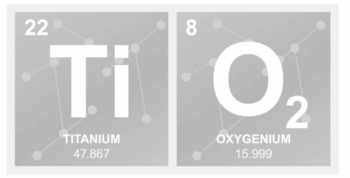Titanium Dioxide
What is Titanium Dioxide?
Titanium dioxide is a simple titanium oxide extracted from naturally occurring minerals, namely ilmenite, rutile, and anatase. When purified from its natural mineral forms, titanium dioxide appears as a white powder. It is primarily used as a pigment in paints and is also a common ingredient in inks, sunscreens, and food colorings.
What is the Chemical Formula of Titanium Dioxide?
Titanium dioxide has the chemical formula TiO₂.
It does not occur in pure form in nature. Instead, it is typically found in combination with other compounds, such as in igneous rocks or as rutile, where it is often present in quartz crystals.
Natural rutile minerals may contain up to 10% iron, as well as significant amounts of niobium and tantalum. Rutile is the most common natural source of titanium dioxide. Less common polymorphs of this compound include anatase, akaogiite, and brookite.
Polymorphs have the same chemical formula but different crystalline structures. For example, rutile has a tetragonal crystalline form, while brookite has an orthorhombic structure. An orthorhombic structure consists of three unequal axes arranged at right angles. Meanwhile, tetragonal forms have crystalline lattices formed by stretching a cubic lattice along one of its lattice vectors. In this arrangement, the cube transforms into a rectangular prism with square bases and height.

What are the Applications of Titanium Dioxide?
The economic demand for titanium dioxide is primarily driven by its properties as a pigment and UV blocker. It is mined and processed as an ingredient for various products, mainly related to the following applications:
- Pigment: TiO₂ was first mass-produced in 1916 for pigment manufacturing. Due to its white color, it is useful for adding opacity to products and is used in paints, coatings, plastics, paper, inks, food, and even pharmaceuticals. As a paint pigment, it achieves a perfectly white color due to the crystalline structure of titanium dioxide particles.
- Sunscreen: TiO₂ is used as an ingredient in sunscreens because it can block ultraviolet rays from the sun, as UV radiation reflects off its particles.
- Thin Reflective Coating: The high reflectivity of TiO₂ makes it an excellent refractive optical coating when applied as a thin film, such as on dielectric mirrors and optics.
- Cosmetics: The high refractive index of TiO₂ crystals provides a glossy finish in makeup and lipsticks. TiO₂ is also used to add a white tint to powders and highlighters while providing a low level of sun protection.
- Ceramic Glazes: The crystalline structure of TiO₂ contributes to its high refractive index and glossy white color, making it an ideal material for ceramic glazes.

Is Titanium Dioxide Safe?
The International Agency for Research on Cancer has classified titanium dioxide as a possible carcinogen for humans. As a result, some countries have begun considering bans on its use in various products, particularly in food colorings, cosmetics, and toothpastes.
Is Titanium Dioxide a Metal?
Although titanium dioxide contains a metal, it is not a metal itself. It is, in fact, a type of mineral that occurs in various forms in nature within igneous and metamorphic rocks alongside other minerals.
The primary indication that it is not a metal is that it lacks the typical characteristics of metals, such as electrical conductivity or malleability. Additionally, metals are typically found in elemental form, whereas titanium dioxide does not occur naturally as an element and must be extracted from minerals like ilmenite and rutile.
 EN
EN RUS
RUS